
Psychedelic rock is a rock music genre that is inspired, influenced, or representative of psychedelic culture, which is centered on perception-altering hallucinogenic drugs. The music incorporated new electronic sound effects and recording techniques, extended instrumental solos, and improvisation. Many psychedelic groups differ in style, and the label is often applied spuriously.
Folk rock is a genre of rock music with heavy influences from English folk and American folk music. Combining the elements of folk and rock music, it arose in the United States, Canada, and the United Kingdom in the mid-1960s. In the U.S., folk rock emerged from the folk music revival. Performers such as Bob Dylan and the Byrds—several of whose members had earlier played in folk ensembles—attempted to blend the sounds of rock with their pre-existing folk repertoire, adopting the use of electric instrumentation and drums in a way previously discouraged in the U.S. folk community. The term "folk rock" was initially used in the U.S. music press in June 1965 to describe the Byrds' music.

The United States of America was an American experimental rock band founded in Los Angeles in 1967 by composer Joseph Byrd and vocalist Dorothy Moskowitz, with electric violinist Gordon Marron, bassist Rand Forbes and drummer Craig Woodson. Their 1968 self-titled album, often cited as an early showcase for the use of electronic devices in rock music, was met with critical acclaim and minor chart success. They disbanded shortly after its release.
Psychedelic folk is a loosely defined form of psychedelia that originated in the 1960s. It retains the largely acoustic instrumentation of folk, but adds musical elements common to psychedelic music.
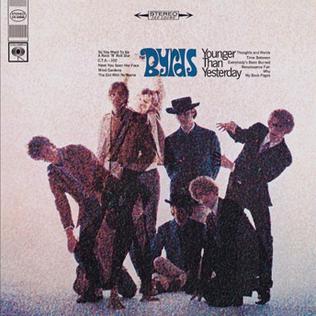
Younger Than Yesterday is the fourth studio album by the American rock band the Byrds and was released on February 6, 1967, on Columbia Records. It saw the band continuing to integrate elements of psychedelia and jazz into their music, a process they had begun on their previous album, Fifth Dimension. In addition, the album captured the band and record producer Gary Usher experimenting with new musical textures, including brass instruments, reverse tape effects and an electronic oscillator.

Mr. Tambourine Man is the debut studio album by the American rock band the Byrds and was released on June 21, 1965, by Columbia Records. The album is characterized by the Byrds' signature sound of Jim McGuinn's 12-string Rickenbacker guitar and the band's complex harmony singing. The material on the album mostly consists of cover versions of folk songs, primarily composed by Bob Dylan, and originals written or co-written by singer Gene Clark. Along with the Dylan-penned single of the same name, Mr. Tambourine Man established the band as an internationally successful act and is widely regarded by critics as representing the first effective American challenge to the chart dominance of the Beatles and other British Invasion bands during the mid-1960s.

Fifth Dimension is the third album by the American rock band the Byrds and was released in July 1966 on Columbia Records. Most of the album was recorded following the February 1966 departure of the band's principal songwriter Gene Clark. In an attempt to compensate for Clark's absence, guitarists Jim McGuinn and David Crosby increased their songwriting output. In spite of this, the loss of Clark resulted in an album with four cover versions and an instrumental, which critics have described as "wildly uneven" and "awkward and scattered". However, it was the first Byrds album not to include any songs written by Bob Dylan, whose material had previously been a mainstay of the band's repertoire.
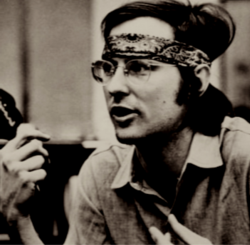
Joseph Hunter Byrd Jr. is an American composer, musician and academic. After first becoming known as an experimental composer in New York City and Los Angeles in the early and mid-1960s, he became the leader of The United States of America, an innovative but short-lived band that integrated electronic sound and radical political ideas into rock music. In 1968 he recorded the album The American Metaphysical Circus, credited to Joe Byrd and the Field Hippies. After working as a record producer, arranger, and soundtrack composer, he became a university teacher in music history and theory.
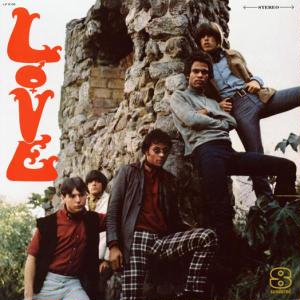
Love is the debut album by the Los Angeles-based rock band Love; released in March 1966 by Elektra Records.

I Got Dem Ol' Kozmic Blues Again Mama! is the debut solo and third studio album overall by American singer-songwriter Janis Joplin, released on September 11, 1969. It was the first album which Joplin recorded after leaving her former band, Big Brother and the Holding Company, and the only solo album released during her lifetime.

The American Metaphysical Circus is a 1969 album by Joseph "Joe" Byrd. It was recorded after his departure from the band The United States of America, and featured some of the earliest recorded work in rock music extensively utilizing synthesizers and vocoder, along with an extended group of West Coast studio musicians Byrd named "The Field Hippies".
The Other Half was an American psychedelic garage rock band, based in San Francisco, and active in the mid-to-late 1960s. The band gained interest after one of the Nuggets compilations in the 1980s included their single, "Mr. Pharmacist".
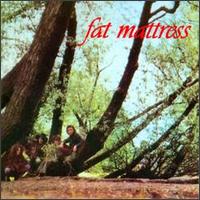
Fat Mattress is the debut self-titled studio album by English rock band Fat Mattress, released on 15 August 1969.

Triangle is the fourth studio album by American rock band the Beau Brummels. Produced by Lenny Waronker and released in July 1967, it was the band's first album to include songs that vocalist Sal Valentino and guitarist Ron Elliott composed together. The band incorporated fantasy elements and surreal characters into the album's song titles and lyrics, and worked with a variety of session musicians to create Triangle's psychedelic musical style. The Beau Brummels were reduced to a trio—Valentino, Elliott, and Ron Meagher—at the time Triangle was recorded, as former group members Don Irving (guitars) and John Petersen (drums) left the band following the release of the group's previous album, Beau Brummels '66.

"Get Me to the World on Time" is a song written by Annette Tucker and Jill Jones for the American garage rock band, The Electric Prunes. The song was released in March 1967 following the success of the band's previous single, "I Had Too Much to Dream ". Although the follow-up did not have the same success, "Get Me to the World on Time" still charted at number 27 on the Billboard Hot 100. The single also fared slightly better in the UK, where it reached number 42.
Dorothy Moskowitz is an American singer and songwriter, who was most notably a lead vocalist in the experimental rock band the United States of America. Moskowitz and the band, though not too commercially successful, produced some of the earliest examples of electronic rock. Following the band's demise, Moskowitz continued her music career, and was a member of Country Joe's All-Star Band.

"Action Woman" is a song by the American garage rock band the Litter, written by their record producer Warren Kendrick, and first released as the group's debut single on Scotty Records in January 1967. The song also appeared on the band's first album Distortions. Although "Action Woman" never broke out on the national charts, it is now revered as a classic piece of the musical genre of garage rock. Accordingly, the composition has appeared on several compilation albums – most famously as the opening track on Pebbles, Volume 1, incorporating a skip in the recording – and has been the subject of cover versions.

"Old John Robertson" is a song by the American rock band the Byrds, written by band members Chris Hillman and Roger McGuinn, and first released in July 1967, as the B-side to the non-album single "Lady Friend". It was also later included on the band's 1968 album, The Notorious Byrd Brothers. The version of "Old John Robertson" featured on the single is a substantially different mix from the version that appeared on The Notorious Byrd Brothers.

"Nowadays Clancy Can't Even Sing" is a song by the Canadian-American folk rock band Buffalo Springfield, released as the group's debut single in August 1966. Neil Young wrote the song in Yorkville in 1965 shortly after returning from a series of performances in Toronto, during a period when his bid at a solo career had been met with little positive response. The lyrics reflect metaphorically on Young's frustration toward his stalled career in music, and was inspired by Ross "Clancy" Smith, an aberrant classmate who incited awe in his school. Commentators recognize "Nowadays Clancy Can't Even Sing" as one of Buffalo Springfield's signature songs, as well as a milestone in Young's progression as a songwriter.
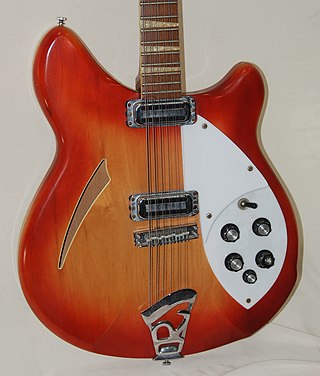
Jangle pop is a subgenre of pop rock or college rock that emphasizes jangly guitars and 1960s-style pop melodies.



















